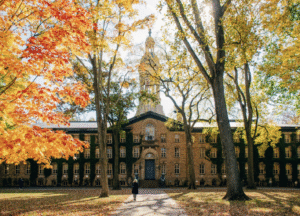Adrianne is a Senior Admissions Counselor and TV/film director, producer, writer, and actress currently based in LA. She uses her experience in multiple disciplines to help students achieve their personal and academic goals.
Whether you’re interested in pursuing STEM subjects in college, are aiming for pre-med, or are just interested in improving your scientific abilities, it’s a great idea to pursue research opportunities for high school students. Read below to learn more!

Table of Contents
Introduction
If you’re a high school student, especially if you’re interested in STEM fields, you might have assumed that you have to wait until college to do any kind of laboratory research or write research papers — but that’s not the case at all. In fact, there are plenty of top-tier research programs that span a wide variety of subjects and interests that are specifically designed for high schoolers.
These programs can help students explore career options, add a new dimension to a college application, and get hands-on experience in academic areas that many high school courses aren’t able to cover. Plus, especially since the pandemic, there are also some great virtual research opportunities if you’re not able to make it to an in-person lab. Additionally, there are summer programs available for high school students to conduct research, as well as opportunities during the school year.
So, why is research a great experience for high schoolers, and where can you find the best opportunity for you or your student?
Why Research Experience Matters for High School Students
Engaging in research during high school offers myriad benefits that can still be useful in the classroom and beyond. Here are just a few unique things research experience allows high schoolers to do:
- Develop critical thinking and problem-solving skills. Research inherently involves tackling questions without clear-cut answers, encouraging students to think critically and approach problems methodically. This process sharpens their analytical skills and boosts their ability to dissect complex issues, which is useful in any field of study or profession.
- Boost your college application. In today’s competitive academic landscape, having research experience on your college application can definitely set you apart, especially at top schools. Admissions committees are always on the lookout for candidates who have invested time in rigorous and meaningful projects and shown a willingness to pursue knowledge outside of the standard classroom environment. Plus, you can always submit any published work as supplemental admissions material.
- Discover your passion and explore potential career pathways. Engaging in research allows students to dive deeper into subjects they’re passionate about, providing clarity on potential future academic and career interests. This experience can be pivotal in helping students decide if they want to specialize in a particular field or explore other areas before committing to a college major.
- Network with professors and specialists in your desired field. When pursuing research as a high schooler, you have the unique opportunity to connect with professors, experts, and peers in your field of choice in a way that’s not usually possible in most high school extracurriculars.
Types of Research Opportunities for High School Students
Not all research programs for high schoolers involve a lab coat and goggles — in fact, you can find research opportunities that fit almost any academic discipline, including non-STEM subjects. Here are just a few types of research opportunities for high school students.
- In-school research programs and independent study projects. This depends on what your school offers, obviously, but if you’re able to take AP Research or conduct your own independent research project for credit, that can be a great way to work on longer-term research that intersects with your coursework. If you’re interested in this option but are unsure if it’s possible, reach out to a teacher or counselor when choosing your classes.
- Research programs hosted by colleges and universities. These programs are often summer camp-style and often for a few weeks on the school’s campus. Examples include MIT’s Research Science Institute, Stanford’s SHTEM, and Broad Summer Research Program (BSRP).
- Virtual research opportunities. If you’re not able to make it to an in-person lab or program, there are online opportunities for high schoolers to get research experience. Some examples include Pioneer Academics, Lumiere Education, and Polygence, where students conduct independent research with a mentor.
- Research competitions and fairs. Students can create and present original research projects for competition or recognition. Some options include Regeneron Science Talent Search (STS), International Science and Engineering Fair (ISEF), and Junior Science and Humanities Symposium (JSHS).
- Non-STEM research. While most research programs and opportunities are catered to STEM research, there are options for students interested in the arts and humanities. It might take a little more work to find these opportunities (i.e., reaching out to professors and possible mentors directly). Possible routes could include historical research projects (such as archival work), policy and social science research (working with think tanks or nonprofits), and creative/arts-based research (exploring theater, film, and media).
How to Find Research Opportunities for High School Students
Ironically, the best way to find research opportunities is to… research! Start at your school and in your community — ask your science teacher and guidance counselor if they know of any local opportunities. Maybe you have a family friend who’s a doctor; that’s a great connection for possible medical research. Reach out to local colleges and universities to see what they might be looking for in terms of research assistants, and see if there is a local research institute you may not have heard of before.
If nothing results from that, you can cast a wider net and go for bigger, more competitive programs. Check out our list of top summer programs for high school students, which includes a decent amount of highly-regarded research programs.
How to Apply to Research Programs for High School Students
The method of applying for a research program varies widely and depends on the type of research it involves. For medical research or biomedical research programs, for instance, there are usually pretty extensive application processes, involving essays, letters of recommendation, and transcripts. This is because these opportunities tend to be more competitive, so students must plan well in advance to give themselves the best chance of success. Some programs may even require that students have previously worked in a research lab and/or are familiar with certain research techniques, so make sure you meet the program’s prerequisites if applicable.
As for more informal research programs, such as one-on-one work with a professor or mentor, that could involve a brief online application through a third-party program or simply a referral from a mutual connection. It’s still good to prepare thoroughly, such as researching more in depth about the scope of laboratory research you’ll be doing before your research even begins.
Making the Most of Your Research Experience
Once you’ve narrowed down your options, applied, and been accepted to your program of choice, you’ll want to make the most of your research opportunity. This means keeping an open mind and remaining curious about all the new experiences you’ll be having.
Before the program even begins, it’s important to set clear goals. Think about what you hope to learn, whether that’s lab techniques, data analysis, or exposure to clinical research. Then, consider what you want to produce, such as a paper, poster, or presentation. Sharing these goals with your mentor early on shows initiative and helps them tailor the experience to your interests.
Regarding your mentor, don’t hesitate to ask them questions. While they may be busy, it’s always beneficial for you to understand the inner workings of the study. Don’t be afraid to ask why things are being done a certain way or why a particular result was achieved. Take notes about the answers you receive, and keep a detailed record of your experiences. You never know when it might come in handy (hint: college applications).
Additionally, don’t forget to network! Introduce yourself to your lab mates or anyone else at the research institute or school. They might be able to connect you to future opportunities or advise you about next steps in your potential career.
Highlighting Research on College Applications
As mentioned above, research is a valuable addition to your college application, especially if you are interested in pre-med programs or any academic opportunities that feature biomedical research. You’ll have a leg up on other students who may not have had exposure to more advanced research techniques, and you’ll have even more insight into your academic interests, which will come in handy on your college essays.
The most direct place to include it is in the Activities section of the Common Application or Coalition Application. Here, students should clearly label their role with a specific title, such as Biomedical Research Intern, Student Researcher at Stanford SIMR, or Independent Neuroscience Researcher, and list the organization, university, or mentor with whom they worked. In the short description, they should focus on the skills and impact of their work rather than just listing tasks. For instance: “Conducted experiments on protein structure to study genetic mutations; co-authored lab report presented at regional symposium.” Students can include links to any published work in the Additional Information section.
Research programs can also provide invaluable content for letters of recommendation, interviews, and essays. Your mentor could be a great option for a supplemental rec letter, especially if they can comment on your intellectual character and mastery of research techniques. In interviews and essays, you can highlight how this experience influenced your decision to pursue your major of choice.
Research Opportunities by Academic Field
As previously mentioned, there are research opportunities available for every subject and academic discipline — see below for some of the top options separated by subject.
STEM (Science, Technology, Engineering, and Mathematics)
- Research Science Institute (RSI) at MIT
- California Institute of Technology’s Summer Research Connection
- Garcia Summer Program at Stony Brook University
- Research in Science & Engineering (RISE) Internship at Boston University
- The Wistar Institute – High School Program in Biomedical Research
- Zuckerman Institute Brain Research Apprenticeships in New York at Columbia University (BRAINYAC)
- UT Austin College of Natural Sciences High School Research Academy
- Max Planck Florida Institute for Neuroscience Program
Social Sciences
- Summer Institute for the Gifted (SIG)
- Clark Scholars Program at Texas Tech University
Humanities
- Humanities and Social Sciences Internship (HSSI)
- Carnegie Mellon’s Summer Academy for Mathematics and Science (SAMS)
- The Science Research Mentoring Program (SRMP) at the American Museum of Natural History
- University of Chicago’s Research in the Humanities
Free and Low-Cost Research Programs for High School Students
While some research programs do come with a large price tag, there are also several free and low-cost options, including some that carry plenty of prestige. Some of the best options are university-affiliated programs, such as the NIH High School Summer Internship Program (HS-SIP), Stanford University’s Institutes of Medicine Summer Research Program (SIMR), Boston University’s RISE Internship Track, and the Research Science Institute (RSI) at MIT — all of which are fully funded or free to attend. Many local universities and community colleges also offer summer camps for high school students with a research component, particularly through partnerships with STEM outreach or diversity initiatives, and these are often free or stipend-based.
Students can also pursue independent or mentor-guided research at little to no cost by reaching out directly to professors or graduate students whose work interests them. Many labs welcome motivated students willing to volunteer or assist with small projects, so if finances may be preventative, sending a thoughtful email to a potential mentor could open up this low-cost or free option.
Conclusion
Research is a great extracurricular option for many high schoolers, not just those who are interested in science-related fields. It can teach students to be proactive and curious in an academic and professional setting, while possibly benefiting students during the college admissions process and beyond.
High schoolers might have to search a bit to find the opportunity that is the best fit for them, but it will certainly be worth the extra work in the long run.
If you’re looking for help finding a research opportunity or general guidance during the admissions process, don’t hesitate to set up a free consultation with one of our consultants today.



